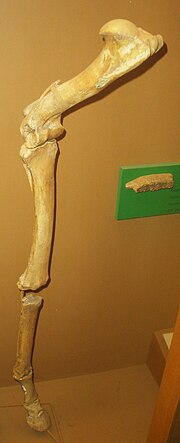European wild ass
| European ass Temporal range: Middle Pleistocene - Holocene
| |
|---|---|

| |
| Scientific classification | |
| Kingdom: | Animalia |
| Phylum: | Chordata |
| Class: | Mammalia |
| Order: | Perissodactyla |
| Family: | Equidae |
| Genus: | Equus |
| Species: | E. hemionus
|
| Subspecies: | †E. h. hydruntinus
|
| Trinomial name | |
| †Equus hemionus hydruntinus Regalia, 1907
| |
The European wild ass (Equus hemionus hydruntinus) or hydruntine is an extinct equine from the Middle Pleistocene to Late Holocene of Western Eurasia. It appeared first in the fossil record around 350–300,000 years before present. In the late Pleistocene it was widespread throughout much of western Eurasia from the Middle East to Europe, especially along the Mediterranean, with fossil reports from Sicily, Turkey, Spain, France and Portugal. In the east the range apparently stretched at least to the Volga and to Iran. In the north it reached almost to the North Sea in Germany and the British Isles.[1] Its range fragmented after the Last Glacial Maximum, surviving into the Holocene, its range gradually contracted further, persisting in small regions of southern Europe into the Bronze Age, and in Iran and the Caucasus into the Iron Age, around 500 BC.[2] It has been suggested that the Iberian Zebro, extinct in the wild from the 16th century, could correspond to the Equus hydruntinus,[3] although the word "zebro" or "cebro" comes from Latin equiferus meaning 'wild horse'.[4] Later research judged that it was unlikely that hydruntines persisted in the Iberian Peninsula beyond the Chalcolithic.[2]
Morphologically the European ass can be distinguished from asses and hemiones particularly by its molars and the relatively short nares. The exact systematic position was formerly unclear but genetic and morphological analysis suggested that it is closely related to the Asiatic wild ass.[5][6] A 2017 genetic study found that it was a subspecies of Asiatic wild ass, closer to the Khur than the Persian onager.[7]
Etymology[]
The specific epithet, hydruntinus, means from Otranto (Hydruntum in Latin).
Ecology[]
The evidence shows that the European ass favoured semi-arid, steppic conditions and showed a preference for temperate climates, although it was also found in cool or cold conditions.[1] It may have retreated to warmer locales during the coldest periods[7] although the relatively short muzzle indicates an adaptation for cold conditions. It preferred open biotopes, between shrubland (favoured by true horses) and grassland (favoured by bovids). It is believed to have shared this habitat with species such as the woolly rhinoceros.[1] It is considered an ecologically important part of the ecosystem known as mammoth steppe where it filled a niche equivalent to that provided by the African wild ass or Zebra in the African Savanna.[8]
See also[]
References[]
- ^ a b c Boulbes, Nicolas; van Asperen, Eline N. (2019). "Biostratigraphy and Palaeoecology of European Equus". Frontiers in Ecology and Evolution. 7: 301. doi:10.3389/fevo.2019.00301. ISSN 2296-701X.
- ^ a b Crees, Jennifer J.; Turvey, Samuel T. (May 2014). "Holocene extinction dynamics of Equus hydruntinus, a late-surviving European megafaunal mammal". Quaternary Science Reviews. 91: 16–29. Bibcode:2014QSRv...91...16C. doi:10.1016/j.quascirev.2014.03.003. ISSN 0277-3791.
- ^ Antunes, M. T. (2006). "The zebro (equidae) and its extinction in portugal, with an appendix on the noun zebro and the modern zebra". In Mashkour, M. (ed.). Equids in Time and Space. Oxford: Oxbow Books. pp. 211–236.
- ^ Nores, Carlos; Morales Muñiz, Arturo; Llorente Rodríguez, Laura (June 2015). "The Iberian zebro: what kind of a beast was it?". Anthropozoologica. 50 (1): 21–23. doi:10.5252/az2015n1a2. S2CID 55004515.
- ^ Burke, Ariane; Eisenmann, Vera; Ambler, Graeme K. (May 2003). "The systematic position of Equus hydruntinus, an extinct species of Pleistocene equid". Quaternary Research. 59 (3): 459–469. doi:10.1016/S0033-5894(03)00059-0. S2CID 84330920.
- ^ Orlando, Ludovic; Machkour, Maryam; Burke, Ariane (July 2006). "Geographic distribution of an extinct equid (Equus hydruntinus: Mammalia, Equidae) revealed by morphological and genetical analyses of fossils". Molecular Ecology. 15 (8): 2083–2093. doi:10.1111/j.1365-294X.2006.02922.x. PMID 16780426. S2CID 9698728.
- ^ a b Bennett, E. Andrew; Champlot, Sophie; Peters, Joris; Arbuckle, Benjamin S.; Guimaraes, Silvia; Pruvost, Mélanie; Bar-David, Shirli; Davis, Simon J. M.; Gautier, Mathieu; Kaczensky, Petra; et al. (2017-04-19). Janke, Axel (ed.). "Taming the late Quaternary phylogeography of the Eurasiatic wild ass through ancient and modern DNA". PLOS ONE. 12 (4): e0174216. Bibcode:2017PLoSO..1274216B. doi:10.1371/journal.pone.0174216. ISSN 1932-6203. PMC 5396879. PMID 28422966.
- ^ Vereshchagin, N. K.; Baryshnikov, G. F. (1991). "The Ecological Structure of the 'Mammoth Fauna' in Eurasia". Annales Zoologici Fennici. 28(3/4) (3/4): 253–259. JSTOR 23735450.
- Equus (genus)
- Pleistocene mammals of Europe
- Extinct mammals of Europe
- Holocene extinctions
- Middle Pleistocene
- Late Pleistocene
- Extinct mammals
- Mammals described in 1907
- Horse stubs